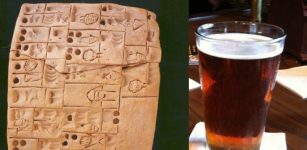Ancient Ziggurat Of Aqar Quf Dedicated To God Enlil
A. Sutherland - AncientPages.com - Aqar Quf, currently an archaeological site of the ancient city of Dur Kurigalzu (or the “Fortress of Kurigalzu”) is located in central Iraq, 30 km northwest of Baghdad, on the left bank of the Euphrates.
It was founded in the 14/15th century BC by the Kassite King Kurigalzu I, (c. 1400–c. 1375) and later the city was several times controlled by the Assyrians and Elamites and in the middle of the 11th-century, BC destroyed by the Syrians.
The ziggurat at Aqar Quf rises 180 feet above the desert west of Baghdad. Image credit: Spc. David Robbins - Working to Restore Iraq's Past for the Future - CC0
The ancient site, which was made up of several tells, was the capital of Babylonia during the reign of the Kassite dynasty (ca. 1600 BC – 1155 BC). After the fall of the Kassite Dynasty, the city was abandoned by the late 14th century AD.
Around the 1940s, an Iraqi and British team led by Taha Baqir and Seton Lloyd found approximately a hundred clay tablets and fragments of a statue decorated with texts in Sumerian. It is a representation of the Kassite King Kurigalzi, who reigned over all of Mesopotamia from his city of Kurigalzu.
Additionally, excavations revealed the ruins of Aqar Quf ziggurat, approximately 3,500 years old. The lowest terrace of the ziggurat ruins was restored and the structure’s foundations are 69 by 67.6 meters.
The ziggurat - dedicated to the god Enlil - is an unusually well-preserved building, with a mud-brick core that still stands to a height of about 170 feet on the flat plain in the vicinity of Baghdad. Other structures included three temples and a palace, where the walls of the corridors, were found decorated with numerous male figures (perhaps court dignitaries), and several sanctuaries.
 Cylinder seal of Kassite king Kurigalzu II (c. 1332–1308 BC). Louvre Museum AOD 105. source
Cylinder seal of Kassite king Kurigalzu II (c. 1332–1308 BC). Louvre Museum AOD 105. source
Interestingly, archaeologists also stumbled upon the remains of another place, which existed there at least a century earlier and was probably called Daksa or Parsa.
At its peak, the city with several ramparts, extended over an area of 225 ha.
The original homeland of the Kassites is not well-known, but appears to have been located in the Zagros Mountains, (now the Lorestan Province of Iran).
The ziggurat of Dur-Kurigalzu was built in the 14th BC by the Kassites’ king Kurigalzu. The central structure is composed of sun-dried bricks. Source
They were a warlike people that invaded Babylon during the 16th century BC and ruled the area for almost six centuries. It is claimed that their rule was the longest in the history of ancient Babylon.
The Kassites were powerful rulers and their royal cities were powerful as well. In addition to Babylon and Dur-Kurigalzu (Aqar Quf), the almost equal city of Nippur was the most important provincial center. Nippur once virtually abandoned c. 1730 BC, but later rebuilt in the Kassite period, as well as Larsa, Susa, and Sippar.
Among the achievements of the art associated with the rule of the Kassites, is the production of modeled bricks. From it, temples decorated with a frieze from burnt brick were erected. This technique was later taken over by the builders from the New-Babylonian period and by the Persians.
Their capital city, Dur-Kurigalzu, was destroyed around the 12th century by the Elamites and the city was burned.
Written by – A. Sutherland - AncientPages.com Senior Staff Writer
Copyright © AncientPages.com All rights reserved. This material may not be published, broadcast, rewritten or redistributed in whole or part without the express written permission of AncientPages.com
Expand for referencesMore From Ancient Pages
-
 What Was The Medieval Shame Flute?
Ancient History Facts | Jan 27, 2020
What Was The Medieval Shame Flute?
Ancient History Facts | Jan 27, 2020 -
 Ancient DNA Of Segorbe Giant Reveals A Brutal Event In Medieval Spain
News | Sep 26, 2021
Ancient DNA Of Segorbe Giant Reveals A Brutal Event In Medieval Spain
News | Sep 26, 2021 -
 Amazing Time Capsule – La Roche-Cotard Cave Sealed For 50,000-Years Offers Evidence Neanderthals Were The World’s First Artists
Archaeology | Nov 22, 2023
Amazing Time Capsule – La Roche-Cotard Cave Sealed For 50,000-Years Offers Evidence Neanderthals Were The World’s First Artists
Archaeology | Nov 22, 2023 -
 1,000-Year-Old Coin And Other Finds Unearthed During Excavations At Carrignacurra Castle in Cork
Archaeology | Oct 6, 2022
1,000-Year-Old Coin And Other Finds Unearthed During Excavations At Carrignacurra Castle in Cork
Archaeology | Oct 6, 2022 -
 Unique Geoglyphs In Torgay, Kazakhstan – Destroyed
Civilizations | Sep 5, 2015
Unique Geoglyphs In Torgay, Kazakhstan – Destroyed
Civilizations | Sep 5, 2015 -
 Oldest Evidence Of Beer Was Found On A Sumerian Tablet In Mesopotamia
Ancient History Facts | Jan 23, 2016
Oldest Evidence Of Beer Was Found On A Sumerian Tablet In Mesopotamia
Ancient History Facts | Jan 23, 2016 -
 Oklahoma’s Mysterious Hollow Hill – Hidden Artifact Reveals A Frightening Story – Part 1
Featured Stories | Jul 8, 2020
Oklahoma’s Mysterious Hollow Hill – Hidden Artifact Reveals A Frightening Story – Part 1
Featured Stories | Jul 8, 2020 -
 New Huge Viking Ship Discovered By Radar In Øye, Norway – What Is Hidden Beneath The Ground?
Archaeology | Apr 9, 2022
New Huge Viking Ship Discovered By Radar In Øye, Norway – What Is Hidden Beneath The Ground?
Archaeology | Apr 9, 2022 -
 America’s Native Population Arises From A Single Wave Of Asian Migration – Dental Anthropologists Say
Archaeology | Dec 19, 2023
America’s Native Population Arises From A Single Wave Of Asian Migration – Dental Anthropologists Say
Archaeology | Dec 19, 2023 -
 Intriguing El Tajin – Pre-Hispanic Ceremonial Site Dedicated To Totonac Rain God
Featured Stories | Jul 17, 2016
Intriguing El Tajin – Pre-Hispanic Ceremonial Site Dedicated To Totonac Rain God
Featured Stories | Jul 17, 2016 -
 Ezekiel’s Secret Ancient Knowledge About Lost Worlds – Thought-Provoking Theory Examined
Featured Stories | May 3, 2019
Ezekiel’s Secret Ancient Knowledge About Lost Worlds – Thought-Provoking Theory Examined
Featured Stories | May 3, 2019 -
 Enormous And Impressive Derawar Fort, Bahawalpur, Pakistan Will Be Restored
News | Sep 14, 2015
Enormous And Impressive Derawar Fort, Bahawalpur, Pakistan Will Be Restored
News | Sep 14, 2015 -
 Feared Skinwalker – Shapeshifter That Uses Mind Control To Hurt Victims In Native American Mythology
Featured Stories | May 16, 2019
Feared Skinwalker – Shapeshifter That Uses Mind Control To Hurt Victims In Native American Mythology
Featured Stories | May 16, 2019 -
 Why Did Winter Baths Become So Popular?
Ancient History Facts | Jan 16, 2024
Why Did Winter Baths Become So Popular?
Ancient History Facts | Jan 16, 2024 -
 Secrets Of Mica Chambers Of Teotihuacan
Ancient Technology | Jun 12, 2020
Secrets Of Mica Chambers Of Teotihuacan
Ancient Technology | Jun 12, 2020 -
 Mystery Of The Watchers And Book Of Enoch – Fallen Angels And Their Secret Knowledge
Biblical Mysteries | Oct 27, 2017
Mystery Of The Watchers And Book Of Enoch – Fallen Angels And Their Secret Knowledge
Biblical Mysteries | Oct 27, 2017 -
 On This Day In History: King Louis XVI Was Executed By Guillotine In Paris – On Jan 21, 1793
News | Jan 21, 2017
On This Day In History: King Louis XVI Was Executed By Guillotine In Paris – On Jan 21, 1793
News | Jan 21, 2017 -
 Omphalos – Mysterious Ancient Sacred Object And Its Meaning
Artifacts | May 24, 2017
Omphalos – Mysterious Ancient Sacred Object And Its Meaning
Artifacts | May 24, 2017 -
 Excavations Of Ancient Theater In 2,400-Year-Old City Of Smyrna, Turkey
Archaeology | Feb 13, 2019
Excavations Of Ancient Theater In 2,400-Year-Old City Of Smyrna, Turkey
Archaeology | Feb 13, 2019 -
 Neanderthals’ History Retrieved From Cave Sediments In Siberia And Spain – New Method
Archaeology | Apr 19, 2021
Neanderthals’ History Retrieved From Cave Sediments In Siberia And Spain – New Method
Archaeology | Apr 19, 2021


